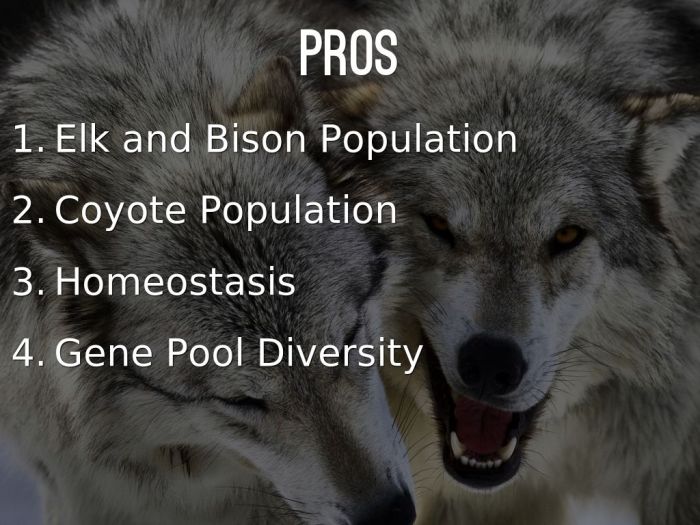The return of canis lupus answer key – The return of Canis lupus, the gray wolf, to various regions worldwide has sparked a fascinating interplay of ecological, cultural, and economic dynamics. This narrative explores the complex history, ecological impacts, human-wolf interactions, and scientific advancements surrounding the resurgence of this iconic predator.
From the decline and recovery of wolf populations to their role in regulating ecosystems and shaping human societies, this article delves into the multifaceted aspects of the return of Canis lupus, offering a comprehensive understanding of its implications and the challenges it presents.
Historical Context

The return of wolves to various regions has been a significant ecological event. Wolves were once widespread throughout North America, Europe, and Asia, but their populations declined dramatically due to hunting, habitat loss, and persecution. In the mid-20th century, wolves were nearly extinct in many areas.
However, conservation efforts and changing attitudes towards wildlife have led to a recovery of wolf populations in recent decades.
One of the most successful wolf recovery programs was the reintroduction of wolves to Yellowstone National Park in the 1990s. This reintroduction has had a profound impact on the ecosystem, helping to restore natural predator-prey dynamics and improve the overall health of the park.
Ecological Impacts
Positive Impacts
- Wolves regulate prey populations, preventing overpopulation and damage to vegetation.
- Wolves help maintain biodiversity by preying on weak or sick animals, allowing healthier individuals to survive and reproduce.
- Wolf presence can lead to changes in prey behavior, such as increased vigilance and reduced browsing, which can benefit other species in the ecosystem.
Negative Impacts
- Wolves can prey on livestock, which can lead to economic losses for ranchers.
- Wolves can compete with humans for game species, such as deer and elk.
- Wolf presence can increase the risk of attacks on humans, although these attacks are rare.
Human-Wolf Interactions: The Return Of Canis Lupus Answer Key

Challenges
- Conflicts between wolves and humans can arise over livestock predation, competition for game species, and perceived threats to human safety.
- Wolves are often feared and misunderstood, which can lead to negative attitudes and persecution.
- Habitat loss and fragmentation can make it difficult for wolves to find food and shelter, increasing the likelihood of conflicts with humans.
Opportunities
- Wolves can provide economic benefits through tourism and hunting.
- Wolf recovery can help to restore natural ecosystems and improve biodiversity.
- Wolves can serve as a symbol of wilderness and conservation.
Cultural and Economic Implications
Cultural Significance
- Wolves have a long and complex history in human cultures, often being seen as symbols of strength, power, and wilderness.
- Wolves feature prominently in mythology, folklore, and literature around the world.
- Wolves hold spiritual significance for many Native American tribes.
Economic Implications
- Wolf recovery can lead to increased tourism revenue, as people come to see wolves in the wild.
- Wolves can help to control deer populations, which can reduce damage to crops and forests.
- Wolves can provide economic benefits through hunting and trapping.
Scientific Research and Management

Scientific Research
Scientists are conducting a wide range of research on wolf ecology and behavior. This research is helping to improve our understanding of wolves and their role in ecosystems.
Current research topics include:
- Wolf population dynamics
- Wolf predation behavior
- Wolf-human interactions
- Wolf conservation genetics
Wolf Management, The return of canis lupus answer key
Wolf management is a complex and challenging task. Managers must balance the needs of wolves with the needs of humans and other wildlife.
Wolf management strategies include:
- Habitat protection
- Population monitoring
- Conflict mitigation
- Education and outreach
FAQ Explained
What factors contributed to the decline of wolf populations in the past?
Habitat loss, overhunting, and persecution by humans were primary factors in the historical decline of wolf populations.
How do wolves benefit ecosystems?
Wolves play a crucial role in regulating prey populations, maintaining biodiversity, and shaping ecosystem dynamics.
What challenges arise from human-wolf interactions?
Conflicts over livestock predation, human safety concerns, and competition for resources pose challenges to human-wolf coexistence.
What cultural significance do wolves hold in different societies?
Wolves have been revered, feared, and depicted in mythology, art, and literature across cultures, reflecting their profound impact on human imagination.
What conservation measures are being implemented for wolf recovery?
Habitat protection, reintroduction programs, and public education initiatives are among the strategies employed to support wolf conservation and recovery efforts.